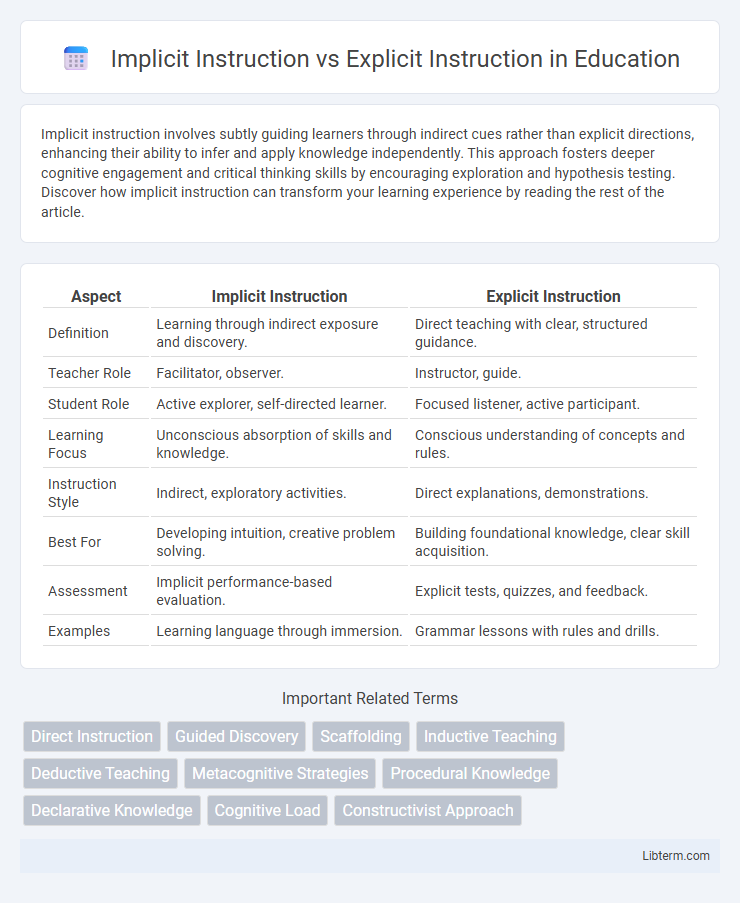Implicit instruction involves subtly guiding learners through indirect cues rather than explicit directions, enhancing their ability to infer and apply knowledge independently. This approach fosters deeper cognitive engagement and critical thinking skills by encouraging exploration and hypothesis testing. Discover how implicit instruction can transform your learning experience by reading the rest of the article.
Table of Comparison
| Aspect | Implicit Instruction | Explicit Instruction |
|---|---|---|
| Definition | Learning through indirect exposure and discovery. | Direct teaching with clear, structured guidance. |
| Teacher Role | Facilitator, observer. | Instructor, guide. |
| Student Role | Active explorer, self-directed learner. | Focused listener, active participant. |
| Learning Focus | Unconscious absorption of skills and knowledge. | Conscious understanding of concepts and rules. |
| Instruction Style | Indirect, exploratory activities. | Direct explanations, demonstrations. |
| Best For | Developing intuition, creative problem solving. | Building foundational knowledge, clear skill acquisition. |
| Assessment | Implicit performance-based evaluation. | Explicit tests, quizzes, and feedback. |
| Examples | Learning language through immersion. | Grammar lessons with rules and drills. |
Understanding Implicit Instruction
Implicit instruction leverages unconscious learning processes by exposing learners to language patterns without direct explanations, fostering natural acquisition through context and repeated exposure. This method emphasizes immersion and real-life communication, allowing learners to internalize rules implicitly rather than through explicit grammar teaching. Understanding implicit instruction highlights its effectiveness in developing intuitive language skills, especially in conversational fluency and comprehension.
Defining Explicit Instruction
Explicit Instruction is a structured teaching method that involves clear, direct teaching of concepts or skills through systematic steps, clear explanations, and guided practice. This approach emphasizes teacher-led demonstrations, immediate feedback, and scaffolding to ensure student understanding and mastery. Research shows that Explicit Instruction significantly enhances learning outcomes in complex skills, literacy, and mathematics by reducing ambiguity and supporting cognitive processing.
Key Differences Between Implicit and Explicit Instruction
Implicit instruction involves learning through exposure and discovery without direct guidance, relying heavily on context and experience to grasp concepts. Explicit instruction provides clear, structured guidance with defined objectives, often using step-by-step teaching methods and direct explanations. Key differences include the level of learner awareness, with explicit instruction emphasizing conscious understanding and implicit instruction fostering unconscious skill acquisition.
Cognitive Theories Behind Instructional Approaches
Implicit instruction relies on unconscious learning processes where learners acquire knowledge through exposure and pattern recognition, tapping into cognitive theories like implicit memory and procedural learning. Explicit instruction emphasizes conscious awareness and deliberate practice, grounded in cognitive theories involving working memory, metacognition, and schema acquisition. Both approaches address different cognitive pathways, with implicit instruction fostering automaticity and explicit instruction promoting strategic understanding and knowledge transfer.
Benefits of Implicit Instruction
Implicit instruction fosters natural language acquisition by exposing learners to authentic context-rich input, which enhances retention and fluency. It supports intuitive learning, minimizing anxiety and encouraging creativity, especially in communicative competence. Research highlights its effectiveness in developing implicit knowledge, leading to more automatic and adaptable language use over time.
Advantages of Explicit Instruction
Explicit instruction offers clear, structured guidance that enhances student understanding by providing step-by-step explanations and immediate feedback. Research shows that explicit instruction improves learning outcomes, particularly in complex subjects like reading and math, by reducing cognitive load and minimizing misconceptions. This method supports diverse learners by scaffolding information and promoting mastery through targeted practice and reinforcement.
Challenges and Limitations of Each Method
Implicit instruction often faces challenges such as slower learner progression and difficulty in ensuring comprehension without direct guidance, which can result in gaps in foundational knowledge. Explicit instruction, while providing clear, structured guidance and immediate feedback, may limit learner autonomy and fail to promote deeper cognitive processing or intrinsic motivation. Both methods encounter limitations related to diverse learner needs and contexts, necessitating adaptive strategies to optimize educational outcomes.
Classroom Applications: When to Use Each Approach
Implicit instruction works best in classrooms with advanced learners who benefit from discovering patterns and concepts through exposure and context, fostering deeper cognitive engagement and long-term retention. Explicit instruction suits beginners requiring clear, direct guidance and step-by-step explanations to grasp foundational skills and concepts efficiently. Teachers often combine both approaches, using explicit methods for introducing new material and implicit strategies to reinforce learning through practice and contextual application.
Impact on Learner Outcomes and Achievement
Explicit instruction, characterized by clear, direct teaching and structured guidance, significantly enhances learner outcomes by providing clear expectations and immediate feedback, leading to higher achievement levels. Implicit instruction, which relies on learners discovering rules and patterns independently, often results in slower progress and less consistent achievement, particularly in complex skill acquisition. Research indicates that combining explicit instruction with opportunities for implicit learning can optimize understanding and retention, ultimately improving overall academic performance.
Choosing the Right Instructional Strategy
Choosing the right instructional strategy hinges on learners' needs, goals, and context, with implicit instruction emphasizing natural acquisition through exposure and explicit instruction providing clear, direct teaching of rules and concepts. Implicit methods benefit language learners by simulating authentic environments that enhance subconscious learning, while explicit instruction accelerates understanding by breaking down complex information into manageable, clear steps. Educators should balance these approaches, tailoring instruction to optimize learner engagement and mastery based on proficiency levels and subject matter complexity.
Implicit Instruction Infographic

 libterm.com
libterm.com